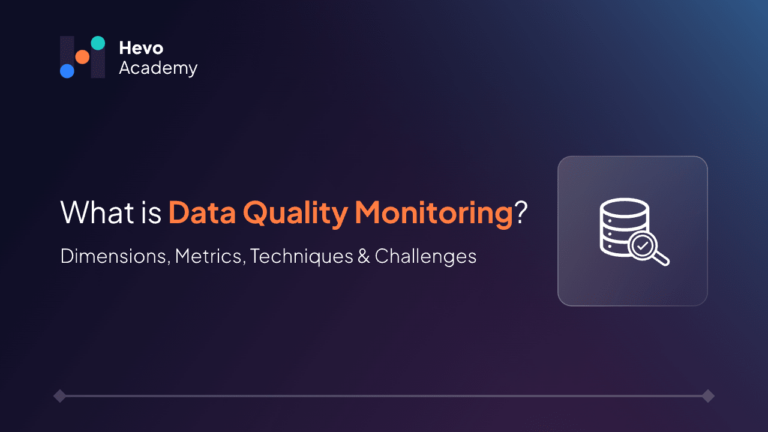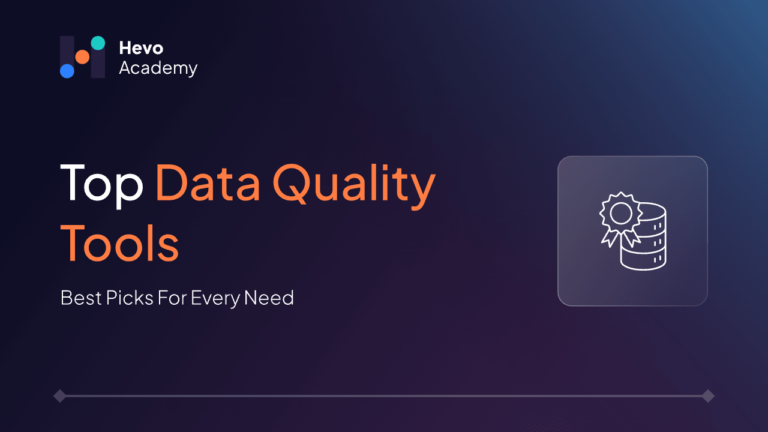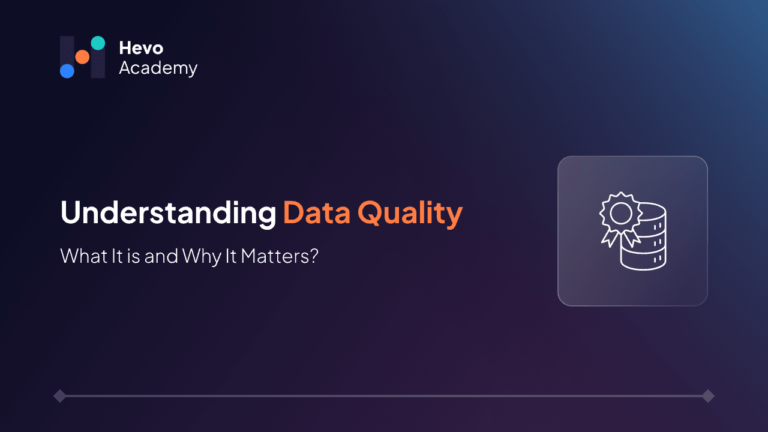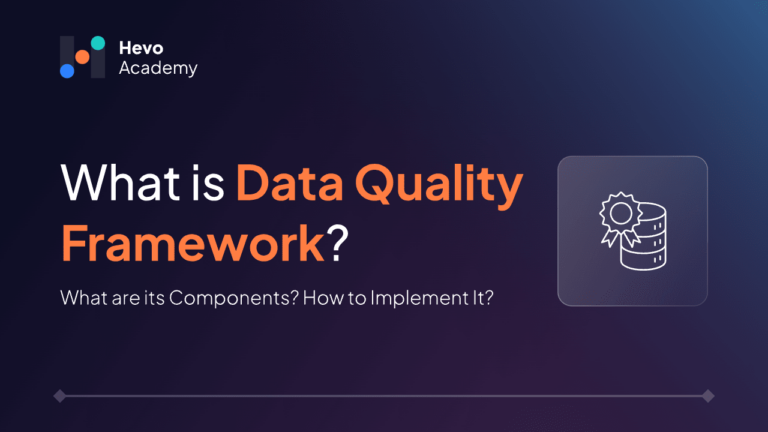If your system has data pipelines, how do you know they are working correctly and that correct data moves through them? As long as you are not monitoring things like data uptime or regularly validating your data, you’ll certainly have some issues down the line.
Table of Contents
You will soon realize that neglecting continuous monitoring has severe consequences. In this case, poor data quality degrades your application before it is triaged and troubleshot. You might have to deal with poor application performance, regulatory and compliance concerns, customer attrition, and revenue loss.
To avoid them, one should invest in data quality monitoring. Here is the primer on the incredibly important aspect of data quality management.
What is data quality monitoring?
Monitoring data quality is measuring and reporting changes over data quality dimensions or concerns. It involves checking, measuring, and guiding data regarding correctness, consistency, and reliability by using numerous strategies to find and correct data quality problems.
Need for data quality monitoring.
Early detection of data quality issues can lead to improvements before small problems become bigger issues that affect the application’s performance and business operations.
However, maintaining data quality is still a challenge. According to Forrester, about 42% of data analysts spend more than 40% of their time checking and validating data. Research conducted by Gartner shows that poor data quality costs companies an average of $15 million in revenue annually.
Common approaches to data quality monitoring include dashboards and alerts. Dashboards highlight vital indicators such as the amount, type, and level of problems with data quality and the percentage of requirements met. They enable you to share the status and trends with many stakeholders and help drive data quality testing efforts.
Alerts will alert you to significant or unexpected changes in the metrics or indicators, like rising errors, loss of completion rate, or deviation from projected ranges. Warnings allow you to act immediately to avoid handling problems that may affect other downstream processes or results. Implementing strong data architecture principles alongside data quality monitoring ensures effective management and scalability, helping you maintain data integrity and prevent operational disruptions.
Dimensions of Data Quality Monitoring
Six features denote high-quality data. This use case explains those six qualities and provides examples of applications. FreshGo is a fictional company that offers next-door quick commerce for fruits, vegetables, and groceries. The company uses data-friendly techniques to optimize its operations and customer services.
The company depends on numerous data types, including customer data, operational data, and market analysis. Let’s learn how the data quality dimensions apply to ‘FreshGo’ data.
| Dimension | Definition | UseCase (FreshGo) |
| Accuracy | The measure by which the data correctly represents the real-world objects or occurrences it aims to depict. | Accurate inventory data ensures customers receive the correct products without errors in quantity or type during deliveries. |
| Consistency | Data must be consistent among systems as well as over time. | Consistency between FreshGo’s website, mobile app, and warehouse stock levels ensures customers can rely on items’ availability when they order. |
| Validity(Relevance) | The data needs to be relevant and applicable to the corporate use it is being designed for. | FreshGo’s marketing and sales data must align with current consumer demand for seasonal produce, allowing for effective promotions and inventory management. |
| Integrity | This means the data must be complete and whole, with no significant parts missing or misrepresented. | Complete and accurate customer delivery information, including address and contact details, is essential for ensuring timely and successful deliveries. |
| Timeliness | The data should be the latest and available when needed, indicating current information. | Real-time updates on delivery schedules and order status are crucial to keeping FreshGo’s customers informed and satisfied with their experience. |
| Uniqueness | Every data element should be unique and not duplicated for clarity and to minimize redundancy. | Unique customer records prevent duplication and may lead to delivery mistakes of service or marketing errors. |
Key metrics to monitor
Error Ratio
The error ratio calculates the percentage of erroneous records in a database. When the error ratio is high, bad data quality will likely lead to false insights and wrong decisions. To calculate the error ratio, divide the number of erroneous records by the total number of entries.
Duplicate record rate
Some systems automatically generate multiple records for a single entity through system failure or human error. These duplicate records waste storage space and can skew analytical results, changing the outcome of decisions that are likely to be made. The percentage of duplicate records in a data set relative to all records made is called the rate of duplicate records.
Data Transformation Errors
Monitor the data pipeline’s performance. This entails tracking and evaluating the rate, duration, volume, and latency at which the pipeline runs and returns the converted data. Log, audit, alert, or dashboarding technologies can be utilized in this process.
Address validity percentage
An exact address becomes crucial for businesses that use location-based services such as deliveries or customer service. The percentage of address validity compares the number of valid addresses in a dataset to the number of total entries that hold an address field. Cleansing and verifying one’s address data should be done frequently to maintain high-quality data.
The volume of dark data
Dark data often originates from organizational silos. Data that could potentially be of value to another team is generated by one team but remains unknown to the other. The breaking of such silos frees up data to the team needing it.
Data time-to-value
Data time-to-value is the speed at which an organization unlocks value from its data after it has been captured. The faster your time-to-value is, the better your organization processes and analyzes data to make business decisions. Monitoring this metric will help you catch bottlenecks in the pipeline and determine if business users have data available at the right time.
List of data quality monitoring techniques
Data Auditing
It is about auditing the validity and accuracy of data by comparing them against already established criteria or standards. It involves identifying and monitoring the data quality problems such as missing, wrong, and inconsistent data.
Data auditing can be done manually by analyzing records through problem detection or automatically by scanning for inconsistencies in data and marking them.
To perform a valid data audit, you must first set up a set of data quality norms and criteria that your data must comply with. Using the data auditing tools, you can then compare this data against these rules and standards and identify anomalies or errors.
Finally, analyze the results of your audit and apply remedial measures to correct any identified data quality problems.
Data cleansing
Data cleansing is identifying and correcting data errors, anomalies, and inaccuracies. To make your data accurate, complete, and reliable, data cleansing techniques use data validation, transformation, and deduplication methods.
The general steps involved in this process are as follows:
- Identifying data quality issues
- Determining the causes of such issues
- Choosing relevant cleansing techniques
- Carrying out cleansing techniques to your data
- Justifying the findings
This is how you get your hands on the quality of data that supports good decision-making.
Data profiling
Data profiling is an umbrella term for activities such as analyzing and understanding your data’s content, structure, and relationships. This process involves reviewing your data at row and column levels so that you identify patterns, anomalies, and inconsistencies. Data profiling gives you all the information about data types, lengths, trends, and unique values that will help you draw insights into the quality of your data.
There are three types of data profiling, namely;
- Column profiling – which measures how every single attribute in a dataset performs.
- Dependency profiling identifies the relationship among attributes.
- Redundancy profiling identifies duplicate data.
Data profiling tools help you gain a complete view of your data and spot quality issues that need to be addressed.
Data quality rules
Explicit criteria through which your data must pass to be accurate, comprehensive, consistent, and reliable. Examples of data quality criteria include duplicate checks, reference data validation, and format or pattern compliance.
Create proper data quality rules based on organizational data quality needs and standards. Then, use data quality tools or custom automation scripts to identify data that did not meet these criteria, indicating anomalies or concerns in your database.
Finally, regularly review and update your data quality standards to ensure they remain relevant and effective in sustaining data quality. Monitoring data quality at this point requires vigilance.
Ingesting the data
Data Ingestion is how data is ingested into a system, and the ingestions come from many internal and external sources. Data can be ingested either in real-time or in batches by the system. Contributed by existing databases, data lakes, real-time systems and platforms (such as CRM and ERP solutions), software and apps, and IoT devices.
Data ingestion is more than just importing raw data. It transfers data from several sources in different formats into one neat and presentable format. Data ingestion can also transform raw, unformatted data into an existing data format.
Apply data ingestion monitoring when you have low-quality data that needs cleaning and formatting for use by other parties.
Metadata management
Metadata management is the process of organizing, preserving, and using metadata to improve data quality, consistency, and usability. Metadata is data about data; it includes definitions, lineage, and quality rules that can help businesses better understand and manage their data.
Using a strong metadata management standard improves data quality and ensures that your company can access, understand, and use it.
Create a metadata repository that stores and organizes metadata in an organized manner. Then, use the metadata management solutions to capture, preserve, and update your information.
Data performance testing
Data performance testing analyzes efficiency, efficacy, and scalability in data processing systems and infrastructure. This method helps data practitioners ensure that their systems handle increasing data quantities, complexity, and velocity without compromising data quality.
Put performance standards and goals for your data processing systems in place and use test tools to simulate deeply involving data processing scenarios with data performance testing tools. You have everything you need to monitor and track your system performance with set benchmarks and objectives.
At last, analyze your data performance testing results and implement all the necessary adjustments to your systems and infrastructure for data processing.
Real-time Monitoring of Data
This aspect involves monitoring and evaluating data in real-time as it is generated, processed, and stored in your company. Do not wait until regular data audits or reviews are conducted; monitor quality data, discovering and correcting issues as they occur.
Real-time data quality monitoring helps you maintain high-quality data, and decision-making is based on proper, current, and precise data.
Monitoring data quality metrics
The data quality metrics (dimensions) we discussed above are quantitative measures that help organizations determine the correctness of their data. Use them to:
- Monitor and track data quality over time
- Identify trends and patterns
- Measure the effectiveness of your data quality monitoring efforts
Identify which data quality metrics apply to the requirements and your organization for data quality. Use data quality tools or your custom scripts to compute those metrics for your data so you can measure its quality.
Monitor and analyze your data quality metrics regularly to pinpoint required improvement and ensure that your monitoring tool is effective.
Challenges in monitoring data quality
Data consistency check
There might be several locations in an organization where the same data could be kept. If data is consistent at such places, they “agree.” If you are concerned about inconsistency regarding data quality, find your data sets to determine whether they are identical in all instances.
Data accuracy measurement
Data accuracy is another concern. To take care of this, you have to address multiple issues.
- Difficulties with data integration and transformation
- Data governance and management challenges
- Technological limitations
- Data architecture complexity
- Data pipeline workflow complexity
- Data source synchronization
Benefits of data quality monitoring
Data quality monitoring is similar to a watchdog that is never off task and always looking for mistakes that could affect decision-making processes.
Monitoring data quality has numerous benefits:
- Data implementation is relatively easy.
Monitoring includes a higher degree of accountability. It alerts early, recommends changes, and measures an application’s performance. Consequently, data applications become easier to implement and more trusted. - Optimized organizational decisions
Data quality monitoring prevents the possibility of errors in decisions through inappropriate insights. It also prevents companies from misusing resources or experiencing compliance violations. - Customer-based relationship
Good-quality data monitoring means having data that teams receive with greater accuracy, thereby contributing to better customer relationships, for example, through targeted marketing campaigns or direct contact. - Increased revenue and profit
Quality data monitoring saves resources by avoiding wasting time and money on resource-intensive pre-processing.
Conclusion
Teams should monitor data to ensure valid and reliable data, make informed decisions, enhance operations, and mitigate threats. Applying best monitoring practices through the deployment of automated, robust data quality monitoring solutions is in your interest to improve data quality, detect problems faster, and establish a sound data infrastructure. Sign Up with Hevo for a 14-day Free Trial, or Schedule a Personalized Demo with us.
FAQs
1. How do we measure data quality?
Data quality is measured using metrics such as error rate, completeness ratio, accuracy checks, consistency assessments, and timeliness of data updates.
2. What is monitoring data quality?
Monitoring data quality is assessing and tracking data to ensure it meets standards of accuracy, consistency, completeness, and reliability.
3. What are the 5 C’s of data quality?
The 5 C’s are Completeness, Consistency, Correctness, Currency, and Clarity.
4. What are the 5 criteria used to measure data quality?
The 5 criteria are Accuracy, Completeness, Consistency, Timeliness, and Validity.






